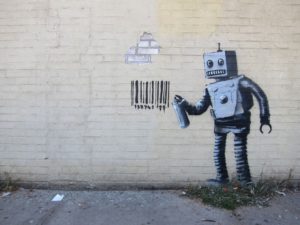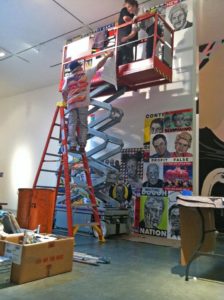1. Introduction: Where We Begin
Clayton Funk
Begin Here
Creativity: Privilege or Human Right?

To create means to produce an action or an artifact, but how does this creation occur? A student of religion might refer to “divine creation” as making something from nothing. But when humans create something, we usually consider the term scientifically, changing the state of a material or an idea, or making something from something. The artifact is the sum and substance of what you sensed and the decisions made during the process of making it. Depending on any limitations and/or controversy in this process, you may feel free to do what you want or you could be concerned about what others will think of it. When each maker finishes their processes and reveals their creations, they may place them in a public setting where they are open to critique and things can get competitive or even political. So even though one who makes an artifact or a song may feel they have the right to create whatever they want, they still have to answer to their critics. We can boil these dynamics down to three considerations: which forms are most important, who decides this, and who decides who gets access?
1) What Visual and Musical Forms are Most Important?
Most of us tend to associate visual and musical forms with varying degrees of power and social status. Walk in to most any art museum or concert hall and you might think you had entered a temple. Many museums were built in the U.S. during what Harpers Magazine called “the Museum Boom,” in the 1880s. They were designed specifically to house art forms that were considered works of genius. Most refined Anglo-Americans believed that studying these fine art forms would inspire what they considered “good character,” but mainly for that privileged, elite class of people. Such visual forms as painting and sculpture were regarded as “high art” and the same social privileges were associated with classical forms of European music. In fact many scholars and artists considered these visual and musical forms to be elite because they derived from their ancient heritage. They were sanctioned by European aristocracy and the predominant Christian denominations, which were regarded as the bedrocks of ordered European civilization at that time. In contrast, these Europeans disregarded the visual and musical forms produced by the indigenous groups, already in North America before the Europeans arrived, as products of cultures they termed “savage.”
This compartmentalizing of art and music by social class and cultural differences may not sound relevant for our time, but remnants of these prejudices are still embedded in American cultural history. The significance of the visual and musical forms of one genre or another depends on which cultural group they come from. Some still consider the visual and musical forms of American Indians or African Americans as different, or even less than the works done according to European “classical” traditions. Even in the 1950s, traditional White parents tended to regard jazz and blues music created by African Americans as improper for their daughters and sons to hear. The creators of elite cultural hierarchies positioned Classical European forms in museums and concert halls as higher and better forms.
2) Who Decides Which of these Forms are Important?

The hierarchies of visual and musical forms are usually backed by the professional expertise of scholars and critics, whose opinions are often regarded with merit because of their advanced knowledge. Ours is a culture of professionalism where experts have an elite body of knowledge they draw upon in service to their clienteles. Teachers, journalists, critics, lawyers, and doctors have had rigorous training and we tend to trust their opinions, or even weigh and compare the opinions of more than one expert. In the art and music world, these professionals have acted as gatekeepers for artists and musicians who have also had advanced professional education. A review by a well-regarded critic gives an artist or musician an advantage over those who go unnoticed. We will study how a Disc Jockey’s (DJ’s) endorsement of recording on radio, in the 1950s, could boost sales into the millions. So for many individuals, what they regard as important art and music tends to depend on what the professionals tell us is high quality.
All this political activity in the distribution of art and music was very common in the twentieth century and still is now; but today’s professional gatekeepers have new competition, thanks to the Internet. Everything from consumer reviews to star ratings provide additional critique from consumers. Even more so, the relatively new process of self-publishing has provided artists and musicians ways of marketing their own work while sidestepping gatekeepers in the middle. In fact anyone with access to a computer and the Internet can now market visual and musical forms. Consequently, the definition of what is regarded as “good or bad” art and music and whose opinion matters, has changed with advances in digital publication and communication.
3) Who decides Who Has Access to These Forms?
Finally, even though the hierarchies ranging from critically acclaimed art and music to the self-publishing of one’s own work have had influence, who finds out about these resources and can benefit from them can still be limited. One hundred years ago, audiences at art museums and concert halls were usually White, gentrified middle and upper class individuals with the money to pay for it. These days, limited access to the commercialized Internet can also stand in the way of someone’s access to online visual and musical forms and learning about them. It is true that public libraries and coffee shops often provide free wifi (even computers in some places), but the power of personal access to the Internet still depends mostly on one’s ability to afford it.
In this course we will study not only art and music to better understand these forms. We will also study where those forms came from and the cultural and economic impact they had on the public. We will also learn about how the artists and musicians dealt with or got around gatekeepers, along with who could get access to these forms of art and music.
More Reading
With the framework, above, in mind, it is time to jump to other resources that address art and music more specifically. follow this link to a menu of readings in our web book, Artist and Musician Biographies: http://aaep1600.osu.edu/book/menu1945.php
Or just follow this list of links:
